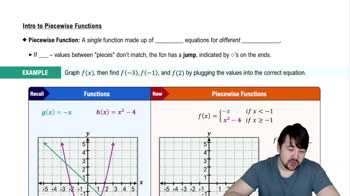Table of contents
- 0. Functions7h 52m
- Introduction to Functions16m
- Piecewise Functions10m
- Properties of Functions9m
- Common Functions1h 8m
- Transformations5m
- Combining Functions27m
- Exponent rules32m
- Exponential Functions28m
- Logarithmic Functions24m
- Properties of Logarithms34m
- Exponential & Logarithmic Equations35m
- Introduction to Trigonometric Functions38m
- Graphs of Trigonometric Functions44m
- Trigonometric Identities47m
- Inverse Trigonometric Functions48m
- 1. Limits and Continuity2h 2m
- 2. Intro to Derivatives1h 33m
- 3. Techniques of Differentiation3h 18m
- 4. Applications of Derivatives2h 38m
- 5. Graphical Applications of Derivatives6h 2m
- 6. Derivatives of Inverse, Exponential, & Logarithmic Functions2h 37m
- 7. Antiderivatives & Indefinite Integrals1h 26m
1. Limits and Continuity
Finding Limits Algebraically
Problem 15
Textbook Question
Suppose g(x) = {2x+1 if x≠0
5 if x=0.
Compute g(0) and lim x→0 g(x)
 Verified step by step guidance
Verified step by step guidance1
Step 1: Identify the value of the function g(x) at x = 0. According to the piecewise definition, g(0) = 5.
Step 2: To find \( \lim_{x \to 0} g(x) \), consider the behavior of g(x) as x approaches 0 from both sides.
Step 3: For x ≠ 0, g(x) = 2x + 1. Analyze the limit \( \lim_{x \to 0} (2x + 1) \).
Step 4: Calculate \( \lim_{x \to 0} (2x + 1) \) by substituting x = 0 into the expression 2x + 1, which simplifies to 1.
Step 5: Compare the limit \( \lim_{x \to 0} g(x) = 1 \) with g(0) = 5 to determine if the function is continuous at x = 0.
Recommended similar problem, with video answer:
 Verified Solution
Verified SolutionThis video solution was recommended by our tutors as helpful for the problem above
Video duration:
3mPlay a video:
Was this helpful?
Key Concepts
Here are the essential concepts you must grasp in order to answer the question correctly.
Piecewise Functions
A piecewise function is defined by different expressions based on the input value. In this case, g(x) has two definitions: one for x not equal to 0 and another specifically for x equal to 0. Understanding how to evaluate piecewise functions is crucial for determining values at specific points and analyzing their behavior around those points.
Recommended video:

Piecewise Functions
Limits
The limit of a function describes the behavior of the function as the input approaches a certain value. In this question, we need to find lim x→0 g(x), which involves evaluating the function as x gets close to 0, but not equal to 0. This concept is fundamental in calculus for understanding continuity and the behavior of functions at points of interest.
Recommended video:

One-Sided Limits
Continuity
A function is continuous at a point if the limit as x approaches that point equals the function's value at that point. For g(x), we need to check if lim x→0 g(x) equals g(0). If they are equal, g(x) is continuous at x=0; if not, it indicates a discontinuity, which is an important aspect of function analysis in calculus.
Recommended video:

Intro to Continuity

 5:21m
5:21mWatch next
Master Finding Limits by Direct Substitution with a bite sized video explanation from Callie
Start learningRelated Videos
Related Practice







